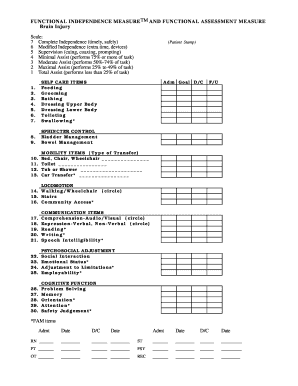
Get Functional Independence Measure And Functional Assessment Measure
How it works
-
Open form follow the instructions
-
Easily sign the form with your finger
-
Send filled & signed form or save
How to fill out the Functional Independence Measure and Functional Assessment Measure online
The Functional Independence Measure (FIM) and Functional Assessment Measure (FAM) are essential tools for assessing a person's level of independence in various daily activities. Completing these forms online can streamline the assessment process and facilitate better service delivery.
Follow the steps to fill out the forms accurately and efficiently.
- Press the ‘Get Form’ button to obtain the form and open it in your preferred editor.
- Begin filling out the personal information section, including relevant details such as patient identification and assessment dates.
- Review the self-care items section. For each item, indicate the level of independence according to the brain injury scale, which ranges from complete independence to total assistance.
- Proceed to the sphincter control section and select the appropriate level of assistance for bladder and bowel management.
- Move on to the mobility items. Specify the type of transfers and indicate the level of assistance required.
- In the locomotion section, assess the ability to walk or use a wheelchair, navigate stairs, and access the community.
- Fill out the communication items by evaluating comprehension and expression modes, including reading and writing abilities.
- Address psychosocial adjustment by considering social interaction, emotional status, and employability.
- Complete the cognitive function section by assessing problem-solving skills, memory, orientation, attention, and safety judgment.
- Lastly, review all entries for accuracy. Save your changes, and choose to download, print, or share the completed form as needed.
Start completing your Functional Independence Measure and Functional Assessment Measure online today!
Related links form
Interpreting the FIM involves understanding the implications of the total score and individual item scores. A higher score indicates greater independence, while a lower score suggests more assistance may be required. By analyzing these results, healthcare providers can tailor interventions that best support the patient's rehabilitation. The FIM serves as an essential tool for tracking progress over time.
Industry-leading security and compliance
-
In businnes since 199725+ years providing professional legal documents.
-
Accredited businessGuarantees that a business meets BBB accreditation standards in the US and Canada.
-
Secured by BraintreeValidated Level 1 PCI DSS compliant payment gateway that accepts most major credit and debit card brands from across the globe.


